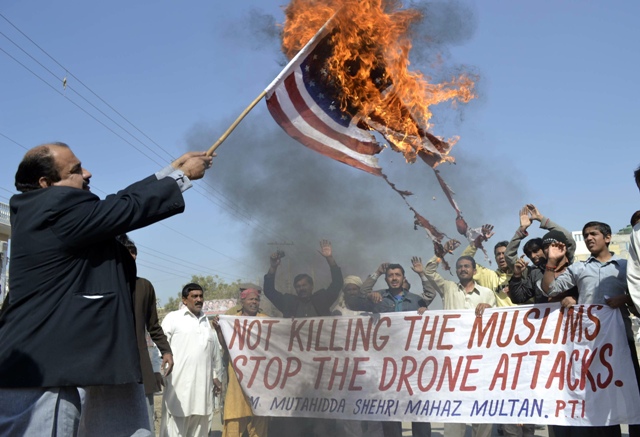John Brennan’s confirmation hearing for CIA Director is stirring up renewed debate on the use of drone strikes as a centerpiece of US counterterrorism strategy and, specifically, the legal grounding for targeting US citizens.
Civil rights advocates, legal scholars, and members of Congress are clamoring for more information about the secret drone program, greater clarity about the legal justification, and clear criteria of when such strikes can be used. A recently leaked Justice Department white paper outlines the administration’s legal argument on the question but that paper has only raised further concerns given the permeable definition of who qualifies as a senior leader of al-Qaeda and the meaning of “imminent” attacks.
A bipartisan group of eleven members of Congress took a stand on the issue and sent a letter to President Obama demanding access to secret legal memos outlining the administration’s case for the targeted killing of US citizens. Their efforts to instill greater oversight over executive authority is laudable—and prompted the president to release the memos to the two relevant congressional committees today—but their letter misses an important point. The debate should not be limited to whether the government can target US citizens accused of terrorist plotting overseas, but rather broadened to examine whether the current drone policy is effective in achieving its goals, or ultimately counterproductive. In short: is the expanded use of drones effective in advancing US national security interests?
Leaving aside the legal and ethical questions—which deserve consideration—there is reason to question the very efficacy of drone strikes as they are unleashed on the front lines against terrorist groups in Afghanistan, Pakistan, Yemen, Somalia, and soon perhaps Mali. Often the short-term gain of eliminating a target trumps consideration of the secondary and tertiary impact that may undermine the very goals we seek to achieve. Although Brennan claimed last year that US drone strikes had not resulted in “a single collateral death” over a period of a year, it is clear that even with the most sophisticated technology and precision, the attacks have mistakenly killed dozens of civilians in Pakistan, Yemen, and Afghanistan. Such mistakes heighten tensions with would-be allies. As Pakistani ambassador to the United States Sherry Rehman noted in a recent interview, “CIA drone strikes in Pakistan are a clear violation of our sovereignty and a violation of international law that threaten stable relations between the two governments.”
Even former General Stanley McChrystal, who led the Joint Special Operations Command, is worried that drones are increasingly targeting low-level militants who do not pose a direct threat to the United States. This expansion increases the likelihood of hitting bystanders generating visceral hostility among the local population who may become more sympathetic to militants’ aims. Part of the problem is that the initial criteria for use of drones in counterterrorism operations—targeting a senior leader of al-Qaeda, whose capture is infeasible and who is plotting a violent attack against the United States—seems to have eroded. The introduction of so-called “signature strikes” defines a target based not on an individual’s identity but rather on a suspicious pattern of behavior. For example, in Yemen, exact figures are difficult to confirm but signature strikes have broadened the scope and number of attacks by significant proportions. The threshold is far lower for approval, and thus the likelihood of injuring or killing innocent bystanders and causing collateral damage to property has increased exponentially. Specific numbers closely held by the US government, but independent sources estimate that up to 178 civilians have been killed in Yemen since the drone campaign began.
“Winning hearts and minds” is a key component of counterinsurgency and counterterrorism; the widespread use of drones is achieving exactly the opposite. In Yemen, most people I’ve spoken with admit that AQAP is a real threat and that action must be taken to root out extremist networks; many would even accept that the United States will use drones in Yemeni airspace to take out high-level targets that have pledged or planned acts of terror against Americans. What is not acceptable, however, is the number of civilians killed in the process. This is where the United States is losing the battle and potentially creating a new layer of problems that will need to be solved.
It has been reported that Brennan favors greater restraint in the use of drone strikes; he has been the lead advocate for the move to codify and increase transparency regarding the rules governing attacks, and has reportedly argued for making the Defense Department, rather than the CIA, the sole owner of the drone program. If he is confirmed as CIA director, one hopes he would continue with both these efforts and move authority for drone strikes to the Pentagon’s Joint Special Operations Command, which has greater obligations for legal accountability. Even with these changes, Congress should press the administration to grapple with these difficult questions and look more deeply at the costs and benefits inherent in such actions. The United States should move away from signature strikes that may do more harm than good. As it stands now, our current drone policy, while perhaps legally justifiable, is neither sustainable nor effective in achieving long-term US security interests.
Danya Greenfield is deputy director of the Rafik Hariri Center for the Middle East at the Atlantic Council.
Image: drone-strikes-protest.jpg
